Jaguar I Pace India review, test drive
Can Jaguar’s take on the luxury EV crossover set itself apart from the others on the market?
Published on Jun 16, 2021 05:45:00 PM
72,530 Views
Follow us on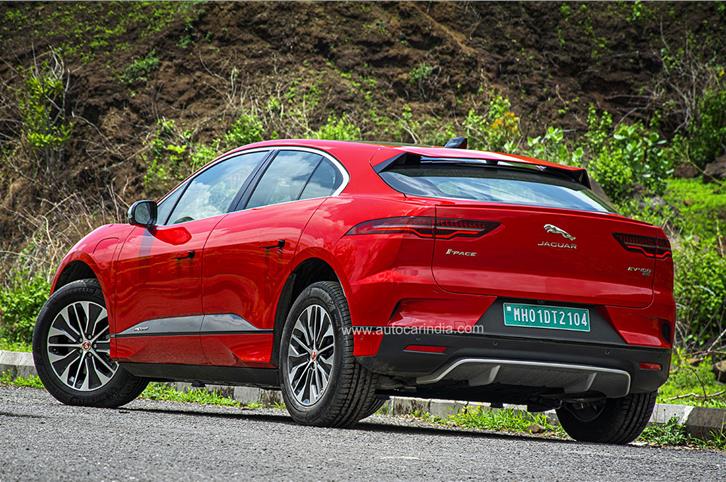

We Like
- Fun to drive
- Impressive range
We Don't Like
- Fiddly infotainment system
- Pricey
Jaguar I Pace: What is it?
The I-Pace might have started life as Jaguar’s first ever battery electric vehicle (BEV), but has since unwittingly become the face of a new Jaguar amidst the brand’s ambitious plan to go all-electric by 2025. Built on a bespoke EV platform and designed to make the most of the packaging freedom electric cars allow, the I-Pace is a Jaguar like no other in more ways than one.
To run through some headline numbers, the Jaguar I-Pace makes 400hp and 696Nm from its dual motors, draws power from a 90kWh lithium-ion battery pack and has a WLTP range of 480km. Jaguar I Pace prices start at Rs 1.06 crore for the S version, while the top-spec HSE featured here comes in at Rs 1.12 crore (ex-showroom, India). This pricing puts the I-Pace on par with its luxury electric SUV rival, the Mercedes-Benz EQC. The Audi e-tron that comes soon will also be in the same price band.
Jaguar I Pace: What’s it like on the outside?
In a word, radical. Jaguar’s designers have made the most of the design flexibility an EV allows (there’s no bulky engine or gearbox to work around) and it shows in the way the I-Pace looks. Sure, the ‘raised eyebrow’ headlights and square grille are familiar Jaguar, but the stubby bonnet, cab-forward design and large passenger cell are a big departure from the traditional SUV silhouette. Even the rake of the rear windscreen is a break from the norm. Whether the look works for you comes down to personal taste, though the attention the 4.6m long I-Pace drew over a day’s driving was quite revealing. The Jag looks futuristic and really stands out.

The I-Pace is also peppered with lots of interesting details designed to aid aero. The door handles sit flush with the body – Range Rover Velar-like – and only pop out when the car is unlocked. There are also vanes in the grille that open only when the battery needs additional cooling. When the vanes are shut, the air flows through a bonnet scoop, over the windscreen and onto the roof. Walk to the back and you’ll note the I-Pace doesn’t have a rear windscreen wiper; Jaguar’s designers say the minimal turbulence at the back keeps dust and grime from accumulating on the window. In practice, the arrangement works well and you can see through the rear window even on a rainy, day but for best visibility you should tick the option for the superb ‘ClearSight’ feature that relays a feed from a roof-mounted camera to the rear view mirror.
Jaguar I Pace: What’s it like on the inside?
With its digital instruments, touchscreens and minimalist design, the I Pace interior is new-age cool. You’ll also love how airy it feels. The windows are large and the panoramic glass roof that’s standard on India-spec cars only helps the feeling of space. Unusually, there’s no blind for the roof. Jaguar says the glass absorbs infrared rays and keeps the cabin cool at all times of day. We didn’t have cause for complaint on the overcast day we drove the I-Pace, but the true test of the claim would be on a bright and hot summer’s day.
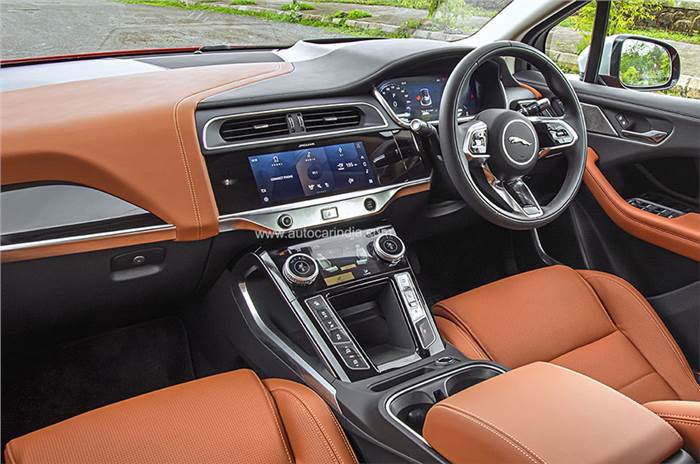
Drivers will like the view out the front, though you might need some time to judge the front extremities of the car; the windscreen extends far forward and this takes some getting used to. The sculpted and multi-way adjustable front seats, chunky steering and smart digital dials do put you at ease, though. The layered dashboard is also well turned out, and the floating arms of the lower portion of the centre console with buttons for the gears, mode selector and suspension adjustment is well done too. But what’s an EV without a sophisticated and/or complicated and/or oversized touchscreen arrangement? The I-Pace features Jaguar’s Touch Pro Duo system with a main 10-inch touchscreen on the dash and a smaller 5.5-inch unit for the climate control system lower down. Thankfully, Jaguar hasn’t ditched physical knobs for temperature and fan settings. The main touchscreen is quick and slick, but isn’t as intuitive as we’d have liked.
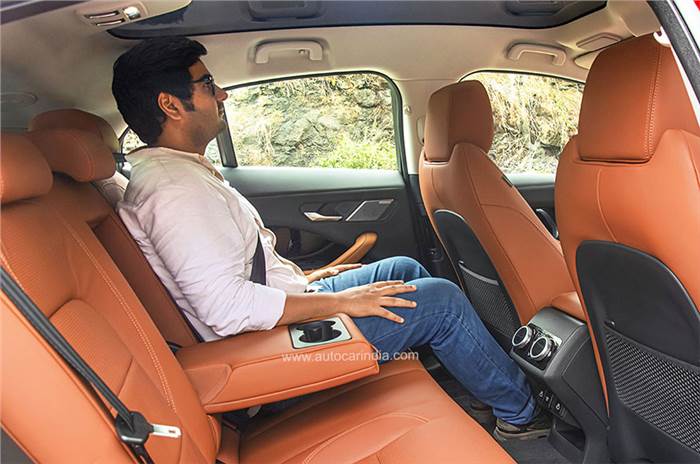
Those seated at the back won’t complain about space. Legroom and headroom are adequate even for six footers, though the rear windows are small, but the massive glass roof gives an airy feel to the cabin. The rear seatback is a bit upright and the seating position is a bit knees up, a consequence of the battery pack positioned under the floor, but on the whole, comfort at the back is pretty good. Interestingly, there’s some storage under the seats too, and you’ll find recesses for all sorts of knickknacks in this cabin, including a 10.5-litre bin between the front seats.

Luggage space at the back is quoted at a massive 656 litres. Trouble is, the space-saver tyre sits on the boot floor and drastically cuts into usable space. There’s a 27-litre storage binnacle (aka frunk!) under the bonnet too.
Jaguar I Pace: What features does it get?
As standard, the I-Pace gets 19-inch alloy wheels, LED headlamps, front and rear parking sensors, a 360-degree camera, connected tech, a panoramic glass roof, two-zone climate control and a powered tailgate. However, given the (relatively) small added outlay over the S and SE trim models, the fully-loaded HSE trim is the I-Pace to buy. The HSE packs in Matrix LED headlamps, 16-way adjustable powered front seats (with heating and cooling), adaptive cruise control, a heads-up display, a sweet-sounding Meridian 3D sound system, and gesture-controlled tailgate. What is disappointing is that air suspension and four-zone climate control are only available as options and will add big to the price.
Jaguar I Pace: What’s it like to drive?
Whoever feels electric cars are no more than glorified appliances needs to drive an I-Pace. It’s quiet and quick, as expected, but the real revelation is its handling. It’s quick to turn (there’s torque vectoring by braking), it feels agile and the superb grip from the all-wheel drive gives you the confidence to push hard. There’s also a beautiful connection that you get at the steering – it’s well weighted and has the right level of heft for different speeds. You really wouldn’t expect a 2.2-tonne high-riding crossover to be so engaging. The secret sauce is the position of the heavy battery pack under the floor that gives it a low centre of gravity. A motor at each axle also allows a 50:50 weight distribution.
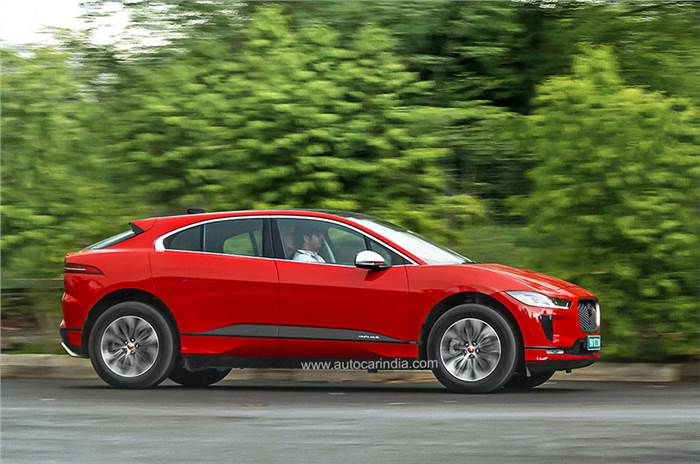
Performance is another I-Pace highlight. We timed the Jag and managed 0-100kph in 4.8 seconds. That’s sportscar performance from a five-seat electric SUV! With 400hp and 696Nm on call, acceleration is brisk at all speeds. The seamless power delivery and immediacy of response is addictive, and there’s a smugness in knowing overtaking traffic is little more than a short press of the accelerator pedal away. Impressively, there’s no shortage of power even in the conservative Eco mode.
For all its power and performance, the I-Pace also makes for a calm everyday car. The drivetrain is all but silent and, at city speeds, there’s little road noise to break the peace inside. Should you miss your beloved petrol or, ahem, diesel-engine car, you have the option to hear synthesised engine notes streaming from the speakers. The V8-like note is cool and disorienting in equal measure! Jaguar has also dialed in a selectable creep mode and, of the other things, you can alter the regen braking force too, with ‘High’ akin to strong engine braking.

On its optional air suspension, the I-Pace rides well too. Big bumps and potholes are dealt with admirably well, with the chunky tyres ably absorbing the initial impact. The option to raise the suspension by 56mm (for up to 230mm of ground clearance) comes in handy, and we were quite impressed by how readily the I-Pace clawed up a mild off-road path.
Jaguar I Pace: What about range and charging?
As mentioned, the Jaguar I-Pace has a WLTP range of 480km. While we are yet to put the Jag through our instrumented real world range test, a day’s driving in town, on the highway and with a few acceleration tests thrown in, yielded an estimated range of 350-360km on a full charge, which is impressive as EVs go.
The I-Pace can be charged at home via a 15amp socket to full in 48 hours, while the 7kW AC wall charger provided with the car brings charging time down to 14 hours. DC fast charging at 25kW juices up the battery pack from 0-80 percent in 3.5 hours, while a 50kW DC fast charger reduces charging time to 1.5 hours.
Jaguar I Pace: Should you buy one?
It would be wrong to give a definitive verdict on the I-Pace without a full-blown test of range and charging. Even so, it’s hard not to come away impressed by the Jag EV.

The I-Pace is interesting in look, feels special inside and offers all the peace and quiet you expect of an EV. What distinguishes the I-Pace, though, is the way it drives. It’s entertaining in a way you wouldn’t expect an EV to be. This fun-to-drive character could be the hook in a field of luxury EVs that are close on price and spec. For now, all we can say is – space, pace and grace; the I-Pace has it all.
Also see:
Jaguar I Pace India video review
Jaguar I-Pace launched at Rs 1.06 crore
Tech Specs 
Copyright (c) Autocar India. All rights reserved.


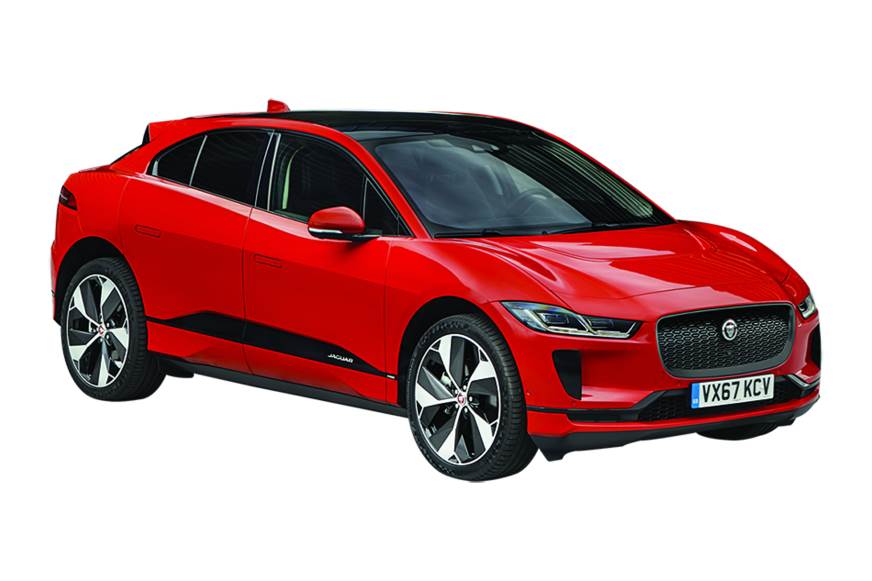



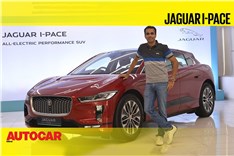
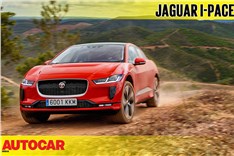
 Engine
Engine Transmission
Transmission Acceleration
Acceleration Brakes
Brakes Dimensions
Dimensions
Comments
Member Login
Personal Details
No comments yet. Be the first to comment.